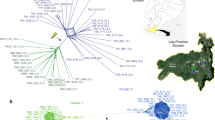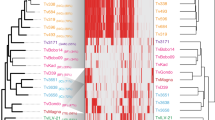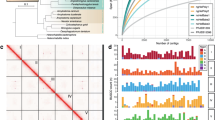Abstract
Trypanosomes of the species Trypanosoma brucei reproduce primarily by binary fission, but the frequency of enzyme elec-trophoretic variants in natural populations of T. brucei has provided indirect evidence for the existence of a sexual cycle1–3. These studies, coupled with studies of restriction fragment length polymorphisms of genes encoding glycolytic enzymes4, have also provided evidence for T. brucei being diploid. Here we report direct evidence of gene exchange between two different clones of trypanosomes after mixed infection and full cyclical development in the tsetse fly vector.
This is a preview of subscription content, access via your institution
Access options
Subscribe to this journal
Receive 51 print issues and online access
$199.00 per year
only $3.90 per issue
Buy this article
- Purchase on Springer Link
- Instant access to full article PDF
Prices may be subject to local taxes which are calculated during checkout
Similar content being viewed by others
References
Tait, A. Parasitology 86, 29–57 (1983).
Gibson, W. C., Marshall, T. F. de C., Fidel, L. & Godfrey, D. G. Adv. Parasit. 18, 175–245 (1980).
Tait, A. Nature 287, 536–538 (1980).
Gibson, W. C., Osinga, K. A., Michels, P. A. M. & Borst, P. Molec. Biochem. Parasit. 16, 231–242 (1985).
Van Meirvenne, N., Janssens, P. G. & Magnus, E. Annls Soc. belge Méd. trop. 55, 1–23 (1975).
Pays, E. et al. Nucleic Acids Res. 8, 5965–5981 (1980).
Paindavoine, P. et al. Parasitology 92, 31–50 (1986).
Geigy, R. & Kauffmann, M. Acta trop. 30, 12–48 (1973).
Felgner, P. et al. Tropenmed. Parasit. 32, 134–140 (1981).
Bauer, B. & Wetzel, H. W. Bull. ent. Res. 65, 563–565 (1976).
Betschart, B., Wyler, R. & Jenni, L. Acta trop. 40, 25–28 (1983).
Tait, A., Babiker, E.A. & Le Ray, D. Parasitology 89, 311–326 (1984).
Brun, R. & Schónenberger, M. Acta trop. 36, 289–292 (1979).
Williams, R. O., Young, J. R. & Majiwa, P. A. O. Nature 299, 417–420 (1982).
McDonnell, M. W., Simon, M. N. & Studier, F. W. J. molec. Biol. 110, 119 (1977).
Cordingley, J. S., Taylor, D. W., Dunne, D. W. & Butterworth, A. E. Gene 26, 25–39 (1983).
Holmes, D. S. & Quigley, M. Analyt. Biochem. 114, 193 (1981).
Southern, E. M. J. molec. Biol. 98, 503–513 (1975).
Maniatis, T., Jeffrey, A. & Kleid, D. C. Proc. natn. Acad. Sci. U.S.A. 72, 1184–1188 (1975).
Author information
Authors and Affiliations
Rights and permissions
About this article
Cite this article
Jenni, L., Marti, S., Schweizer, J. et al. Hybrid formation between African trypanosomes during cyclical transmission. Nature 322, 173–175 (1986). https://doi.org/10.1038/322173a0
Received:
Accepted:
Issue Date:
DOI: https://doi.org/10.1038/322173a0
This article is cited by
-
Experimental genetic crosses in tsetse flies of the livestock pathogen Trypanosoma congolense savannah
Parasites & Vectors (2024)
-
Development of the livestock pathogen Trypanosoma (Nannomonas) simiae in the tsetse fly with description of putative sexual stages from the proboscis
Parasites & Vectors (2023)
-
Biochemical and genotyping analyses of camels (Camelus dromedaries) trypanosomiasis in North Africa
Scientific Reports (2023)
-
Sequential production of gametes during meiosis in trypanosomes
Communications Biology (2021)
-
Fluorescent proteins reveal what trypanosomes get up to inside the tsetse fly
Parasites & Vectors (2019)
Comments
By submitting a comment you agree to abide by our Terms and Community Guidelines. If you find something abusive or that does not comply with our terms or guidelines please flag it as inappropriate.



